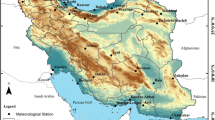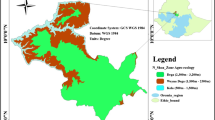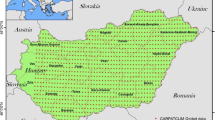Abstract
The analysis of hydroclimate extremes is gaining more attention due to the devastating effects of intense floods, droughts, etc. This study aims to analyze the stationary (S) and non-stationary (NS) behavior of the annual maximum temperatures (AMT) for two different climatic zones of Iran including the arid and excessively humid provinces of Kerman and West Azerbaijan, respectively. The research datasets included maximum temperature (from CRU TS) and soil moisture (from ERA5) on a monthly time scale (spanning 1901–2019 and 1979–2019). Trend, homogeneity, and stationarity tests were applied to define the basic characterization of the AMTs. The frequency analyses of the AMTs were carried out using generalized extreme value (GEV) under two assumptions of S-GEV and NS-GEV. Moreover, the fitted distribution parameters were estimated using a maximum likelihood estimator. In addition to time-varying NS-GEV investigations, the soil moisture during summer (SM-June, July, and August) was also employed as the covariate to quantify the relationship between drought and AMTs in these climatic zones. The research findings revealed that the Akaike information criterion in S-GEV and NS-GEV estimations decreased from 309 to 223 and 329 to 254 for arid and excessively humid climatic zones, respectively. Therefore, the NS-GEV frequency analyses has increasing effects on return levels of the AMTs than the S-GEV. In the following, the spatial NS-GEV investigations in all 12 and 15 stations of both provinces, showed that NS-GEV with SM as a covariate has better performance in excessively humid climatic zones.










Similar content being viewed by others
Data availability
The station-based meteorological data have been prepared from the Ministry of Energy and Meteorological Organization of Iran and after validation have been used. The CRU Tmax dataset and ERA5 soil moisture data were extrracted from https://crudata.uea.ac.uk/cru/data and https://www.ecmwf.int/en/forecasts/datasets/reanalysis-datasets/era5, repectively.
Notes
ECMWF Reanalysis v5.
European Centre for Medium-Range Weather Forecasts.
References
Adams RM, Chen CC, McCarl BA, Weiher RF (1999) The economic consequences of ENSO events for agriculture. Clim Res 13:165–172
Afuecheta E, Omar MH (2021) Characterization of variability and trends in daily precipitation and temperature extremes in the Horn of Africa. Clim Risk Manag 32:100295
AghaKouchak A, Nasrollahi N (2010) Semi-parametric and parametric inference of extreme value models for rainfall data. Water Resour Manag 24:1229–1249
AghaKouchak A, Easterling D, Hsu K, Schubert S, Sorooshian S (2013) Extremes in a changing climate. Springer, Netherlands
Akaike H (1974) A new look at the statistical model identification. IEEE Trans Autom Control 19(6):716–723
Aksu H (2021) Nonstationary analysis of the extreme temperatures in Turkey. Dyn Atmos Oceans 95:101238
Andreadis KM, Lettenmaier DP (2006) Trends in 20th century drought over the continental United States. Geophys Res Lett 33:25
Anvari S, Moghaddasi M, Bagheri MH (2023) Drought mitigation through a hedging-based model of reservoir-farm systems considering climate and streamflow variations. Theoret Appl Climatol 152(1–2):723–737
Archfield SA, Hirsch RM, Viglione A, Blöschl G (2016) Fragmented patterns of flood change across the United States. Geophys Res Lett 43:10–232
Aziz R, Yucel I, Yozgatligil C (2020) Nonstationary impacts on frequency analysis of yearly and seasonal extreme temperature in Turkey. Atmos Res 238:104875
Babaeian I, Karimian M, Modirian R, Mirzaei E (2019) Future climate change projection over Iran using CMIP5 data during 2020–2100. NIVAR J Meteorol Org 43:61–70
Banerjee A, Dolado JJ, Galbraith JW, Hendry D (1993) Co-integration, error correction, and the econometric analysis of non-stationary data. Oxford University Press, Oxford
Bartolini G, Morabito M, Crisci A, Grifoni D, Torrigiani T, Petralli M, Orlandini S (2008) Recent trends in Tuscany (Italy) summer temperature and indices of extremes. Int J Climatol J R Meteorol Soc 28(13):1751–1760
Berghuijs WR, Allen ST, Harrigan S, Kirchner JW (2019) Growing spatial scales of synchronous river flooding in Europe. Geophys Res Lett 46:1423–1428
Cheng L, Gilleland E, Heaton MJ, AghaKouchak A (2014) Empirical Bayes estimation for the conditional extreme value model. Statistics 3(1):391–406
Coles S (2001) An introduction to statistical modeling of extreme values. Springer, London
Darand M (2020) Future changes in temperature extremes in climate variability over I ran. Meteorol Appl 27(6):e1968
Debele SE, Bogdanowicz E, Strupczewski WG (2017) Around and about an application of the GAMLSS package to non-stationary flood frequency analysis. Acta Geophys 65:885–892
Deidda R, Hellies M, Langousis A (2021) A critical analysis of the shortcomings in spatial frequency analysis of rainfall extremes based on homogeneous regions and a comparison with a hierarchical boundaryless approach. Stoch Env Res Risk Assess 35(12):2605–2628
Delgado JM, Apel H, Merz B (2010) Flood trends and variability in the Mekong river. Hydrol Earth Syst Sci 14:407–418. https://doi.org/10.5194/hess-14-407-2010
Do HX, Westra S, Leonard M (2017) A global-scale investigation of trends in annual maximum streamflow. J Hydrol 552:28–43
Donat M, Alexander L, Yang H, Durre I, Vose R, Dunn R, Willett K, Aguilar E, Brunet M, Caesar J et al (2013) Updated analyses of temperature and precipitation extreme indices since the beginning of the twentieth century: the HadEX2 dataset. J Geophys Res Atmos 118:2098–2118
Efron B (1982) Maximum likelihood and decision theory. Ann Stat 10(2):340–356
Emmanouil S, Langousis A, Nikolopoulos EI, Anagnostou EN (2020) Quantitative assessment of annual maxima, peaks-over-threshold and multifractal parametric approaches in estimating intensity-duration-frequency curves from short rainfall records. J Hydrol 589:125151
Emmanouil S, Langousis A, Nikolopoulos EI, Anagnostou EN (2022) The spatiotemporal evolution of rainfall extremes in a changing climate: a CONUS-wide assessment based on multifractal scaling arguments. Earth’s Future 10(3):e2021EF002539. https://doi.org/10.1029/2021EF002539
Ganeshi NG, Mujumdar M, Krishnan R, Goswami M (2020) Understanding the linkage between soil moisture variability and temperature extremes over the Indian region. J Hydrol 589:125183
Ganeshi NG, Mujumdar M, Yuhei T, Goswami MM, Singh BB, Krishnan R, Terao T (2022) Assessing the impact of soil moisture-temperature coupling on temperature extremes over the Indian region. arXiv preprint arXiv:2204.04079
Gao M, Zheng H (2018) Nonstationary extreme value analysis of temperature extremes in China. Stoch Env Res Risk Assess 32(5):1299–1315
Gao M, Mo D, Wu X (2016) Nonstationary modeling of extreme precipitation in China. Atmos Res 182:1–9
Garcia-Aristizabal A, Bucchignani E, Palazzi E, D’Onofrio D, Gasparini P, Marzocchi W (2015) Analysis of non-stationary climate-related extreme events considering climate change scenarios: an application for multi-hazard assessment in the Dar es Salaam region, Tanzania. Nat Hazards 75(1):289–320
Ghorbani K, Bazrafshan Daryasary M, Meftah Halaghi M, Ghahreman N (2016) The effects of climate change on DeMartone climatic classification in Golestan province. Iran J Soil Water Res 47(2):319–332
Hamdi Y, Duluc CM, Rebour V (2018) Temperature extremes: estimation of non-stationary return levels and associated uncertainties. Atmosphere 9(4):129
Hao Z, Hao F, Singh VP, Ouyang W (2017) Quantitative risk assessment of the effects of drought on extreme temperature in eastern China. J Geophys Res Atmos 122(17):9050–9059
Harris I, Osborn TJ, Jones P, Lister D (2020) Version 4 of the cru ts monthly highresolution gridded multivariate climate dataset. Sci Data 7(1):1–18
Hawkes PJ, Gonzalez-Marco D, Sánchez-Arcilla A, Prinos P (2008) Best practice for the estimation of extremes: a review. J Hydraul Res 46:324–332
Hersbach H, Bell B, Berrisford P, Hirahara S, Horányi A, Muñoz-Sabater J et al (2020) The ERA5 global reanalysis. Q J R Meteorol Soc 146(730):1999–2049
Hersbach H, de Rosnay P, Bell B et al (2018) Operational global reanalysis: progress, future directions and synergies with NWP, ERA report series 27, ECMWF, Reading, UK
Hohenegger C, Brockhaus P, Bretherton CS, Schär C (2009) The soil moisture–precipitation feedback in simulations with explicit and parameterized convection. J Clim 22(19):5003–5020
IPCC (2001) Climate change 2001: the scientific basis. In: Houghton JT, Ding Y, Griggs DJ, Noguer M, van der Linden PJ, Dai X, Maskell K, Johnson CA (eds) Contribution of working group 1 to the third assessment report of the intergovernmental panel on climate change. Cambridge University Press, Cambridge, p 881
IPCC (2012) Glossary of terms, in: managing the risks of extreme events and disasters to advance climate change adaptation. In: Barroos CB, Stocker V, Qin TF, Dokken DJ, Ebi KL et al (eds) A special report of working groups I and II of the Intergovernmental Panel on Climate Change (IPCC). Cambridge University Press, Cambridge, pp 555–564
IPCC (2013) Climate change 2013: the physical science basis. In: Stocker TF, Qin D, Plattner G-K, Tignor MMB, Allen SK, Boschung J, Nauels A, Xia Y, Bex V, Midgley PM (eds) Contribution of working group I to the fifth assessmentreport of the intergovernmental panel on climate change. Cambridge University Press, p 1552
IPCC (2007) Summary for policymakers. Climate change 2007: the physical science basis. Contribution of the working group I to the fourth assessment report of the intergovernmental panel on climate change. Cambridge University
Jakob D (2013) Nonstationarity in extremes and engineering design. Extremes in a Changing Climate, Netherlands
Karvanen J (2011) Lmoments: L-moments and quantile mixtures. R Package version 1.1-3. http://CRAN.R-project.org/package=Lmoments
Katz R (2010) Statistics of extremes in climate change. Clim Change 100(1):71–76
Katz RW, Brown BG (1992) Extreme events in a changing climate: variability is more important than averages. Clim Change 21(3):289–302
Katz RW, Parlange MB, Naveau P (2002) Statistics of extremes in hydrology. Adv Water Resour 25(8–12):1287–1304
Kendall MG (1975) Rank correlation methods. Oxford University Press, New York
Kjellström E, Bärring L, Jacob D, Jones R, Lenderink G, Schär C (2007) Modelling daily temperature extremes: recent climate and future changes over Europe. Clim Change 81:249–265
Kumar S, Merwade V, Kam J, Thurner K (2009) Stream flow trends in Indiana: effects of long term persistence, precipitation and subsurface drains. J Hydrol 374:171–183
Kwiatkowski D, Phillips PC, Schmidt P, Shin Y (1992) Testing the null hypothesis of stationarity against the alternative of a unit root: How sure are we that economic time series have a unit root? J Econometr 54(1–3):159–178
Ledger ME, Milner AM (2015) Extreme events in running waters. Freshw Biol 60(12):2455–2460
Li L, Zhang L, Xia J, Gippel CJ, Wang R, Zeng S (2015) Implications of modelled climate and land cover changes on runoff in the middle route of the south to north water transfer project in China. Water Resour Manag 29(8):2563–2579
Lorenz R, Stalhandske Z, Fischer EM (2019) Detection of a climate change signal in extreme heat, heat stress, and cold in Europe from 20 observations. Geophys Res Lett 46:8363–8374
Mann HB (1945) Nonparametric tests against trend. Econometrica 13:245–259. https://doi.org/10.2307/1907187
Marengo JA (2010) Extreme weather and climate events in Brazil. FBDS, p 76
Mearns LO, Katz RW, Schneider SH (1984) Extreme high-temperature events: changes in their probabilities with changes in mean temperature. J Appl Meteorol Climatol 23(12):1601–1613
Milly PC, Betancourt J, Falkenmark M, Hirsch RM, Kundzewicz ZW, Lettenmaier DP, Stouffer RJ (2008) Stationarity is dead: Whither water management? Science 319:573–574
Miralles DG, Van Den Berg MJ, Teuling AJ, De Jeu RAM (2012) Soil moisture-temperature coupling: a multiscale observational analysis. Geophys Res Lett 39(21):25
Miralles DG, Teuling AJ, Van Heerwaarden CC, Vilà-Guerau de Arellano J (2014) Mega-heatwave temperatures due to combined soil desiccation and atmospheric heat accumulation. Nat Geosci 7(5):345–349
Mitchell TD, Jones PD (2005) An improved method of constructing a database of monthly climate observations and associated high-resolution grids. Int J Climatol J R Meteorol Soc 25(6):693–712
Moghaddasi M, Anvari S, Akhondi N (2022a) A trade-off analysis of adaptive and non-adaptive future optimized rule curves based on simulation algorithm and hedging rules. Theoret Appl Climatol 148(1):65–78
Moghaddasi M, Anvari S, Mohammadi T (2022b) Comparison of extreme value theory approaches in temperature frequency analysis (case study: Arak plain in Iran). Arab J Geosci 15(12):1–13
Mueller B, Seneviratne SI (2012) Hot days induced by precipitation deficits at the global scale. Proc Natl Acad Sci 109(31):12398–12403
New M, Hulme M, Jones P (1999) Representing twentieth-century space–time climate variability. Part I: development of a 1961–90 mean monthly terrestrial climatology. J Clim 12(3):829–856
Obeysekera J, Salas JD (2014) Quantifying the uncertainty of design floods under nonstationary conditions. J Hydrol Eng 19(7):1438–1446
Oliver EC, Donat MG, Burrows MT, Moore PJ, Smale DA, Alexander LV et al (2018) Longer and more frequent marine heatwaves over the past century. Nat Commun 9(1):1–12
Ouarda TB, Charron C (2018) Nonstationary temperature-duration-frequency curves. Sci Rep 8:1–8
Perkins SE, Alexander LV (2013) On the measurement of heat waves. J Clim 26:4500–4517
Pettitt AN (1979) A non-parametric approach to the change point problem. J R Stat Soc Ser C Appl Stat 28:126–135
Raykov T, Marcoulides GA (1999) On desirability of parsimony in structural equation model selection. Struct Eq Model 6(3):292–300. https://doi.org/10.1080/10705519909540135
Razmi A, Golian S, Zahmatkesh Z (2017) Non-stationary frequency analysis of extreme water level: application of annual maximum series and peak-over threshold approaches. Water Resour Manag 31(7):2065–2083
Rosbjerg D, Madsen H (1998) Design with uncertain design values. In: International conference on hydrology in a changing environment. Wiley, pp 155–163
Ryden J (2023) A tale of two stations: a note on rejecting the Gumbel distribution. Acta Geophys 71(1):385–390
Sen PK (1968) Estimates of the regression coefficient based on Kendall’s Tau. J Am Stat Assoc 63:1379–1389
Seneviratne SI, Nicholls N, Easterling D, Goodess CM, Kanae S, Kossin J, Luo Y, Marengo J, McInnes K, Rahimi M (2012) Changes in climate extremes and their impacts on the natural physical environment, managing the risks of extreme events and disasters to advance climate change adaptation, pp 109–230
Slater LJ, Anderson B, Buechel M, Dadson S, Han S, Harrigan S, Wilby RL (2021) Nonstationary weather and water extremes: a review of methods for their detection, attribution, and management. Hydrol Earth Syst Sci 25(7):3897–3935
Spinoni J, Naumann G, Vogt JV (2017) Pan-European seasonal trends and recent changes of drought frequency and severity. Global Planet Change 148:113–130
Sun Q, Zhang X, Zwiers F, Westra S, Alexander LV (2020a) A global, continental and regional analysis of changes in extreme precipitation. J Clim 20:1–52
Ter Braak CJF (2006) A Markov chain monte Carlo version of the genetic algorithm differential evolution: easy Bayesian computing for real parameter spaces. Stat Comput 16:239–249
Ter Braak CJF, Vrugt JA (2008) Differential evolution Markov chain with snooker updater and fewer chains. Stat Comput 18:435–446
Teuling AJ, Seneviratne SI (2008) Contrasting spectral changes limit albedo impact on land-atmosphere coupling during the 2003 European heat wave. Geophys Res Lett 35(3):25–68
Vanem E (2015) Non-stationary extreme value models to account for trends and shifts in the extreme wave climate due to climate change. Appl Ocean Res 52:201–211
Vrugt JA et al (2009) Accelerating Markov chain monte Carlo simulation by differential evolution with self-adaptive randomized subspace sampling. Int J Nonlinear Sci Numer Simul 10:273–290
Wambua MM, Mungatu JK, Aduda JA (2020) Modelling extreme temperature using extreme value theory: a case study Northern Kenya. Int J Data Sci Anal 6(5):130
Westra S, Alexander LV, Zwiers FW (2013) Global increasing trends in annual maximum daily precipitation. J Clim 26(11):3904–3918
Whan K, Zscheischler J, Orth R, Shongwe M, Rahimi M, Asare EO, Seneviratne SI (2015) Impact of soil moisture on extreme maximum temperatures in Europe. Weather Clim Extremes 9:57–67
Zamani R, Berndtsson R (2018) Evaluation of CMIP5 models for west and southwest Iran using TOPSISI-based method. Theoret Appl Climatol 137:533–543
Acknowledgements
This research work was supported by the Graduate University of Advanced Technology (Institute of Science and High Technology and Environmental Science) (No. 1401/3022), which the authors gratefully acknowledge. The authors also appreciate the time and feedback of the editor and the anonymous reviewers, who provided valuable suggestions and comments that helped improve the manuscript.
Funding
This research work was supported by the Graduate University of Advanced Technology (Institute of Science and High Technology and Environmental Science) (No. 1400/2659). The authors gratefully acknowledge this help.
Author information
Authors and Affiliations
Contributions
SA and MM performed material preparation, data collection and analysis. SA wrote the first draft of the manuscript and responded to reviewers. All authors, SA and MM, read and approved the final manuscript.
Corresponding author
Ethics declarations
Conflict of interest
The authors declare no conflict of interest. There is no conflict of interest regarding the publication of this article. The authors of the article make sure that everyone agrees to submit the article and is aware of the submission.
Additional information
Publisher's Note
Springer Nature remains neutral with regard to jurisdictional claims in published maps and institutional affiliations.
Rights and permissions
Springer Nature or its licensor (e.g. a society or other partner) holds exclusive rights to this article under a publishing agreement with the author(s) or other rightsholder(s); author self-archiving of the accepted manuscript version of this article is solely governed by the terms of such publishing agreement and applicable law.
About this article
Cite this article
Anvari, S., Moghaddasi, M. Historical changes of extreme temperature in relation to soil moisture over different climatic zones of Iran. Stoch Environ Res Risk Assess 38, 157–173 (2024). https://doi.org/10.1007/s00477-023-02558-2
Accepted:
Published:
Issue Date:
DOI: https://doi.org/10.1007/s00477-023-02558-2




